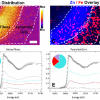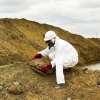Yvonne Fors,a Håkan Grudd,b Anders Rindbyc and Lennart Bornmalmd
aDepartment of Conservation, University of Gothenburg, Sweden
bBolin Centre for Climate Research, Department of Physical Geography, Stockholm University, Sweden
cCox Analytical Systems, Mölndal, Sweden
dSciences and Department of Biology and Environmental Sciences, University of Gothenburg, Sweden
The challenges of archaeological wooden treasures recovered from the seabed
Archaeological wood constitutes an important part of our cultural heritage, and the finds recovered from excavation sites may represent a broad range of different objects. This is particularly true for well-preserved shipwrecks, such as the famous Vasa (1628) (Figure 1) of Sweden and the British Mary Rose (1545). The wreck site context of such vessels offers a rich source of archaeological information, and the shipwrecks themselves usually constitute strong historical symbols.1,2

Waterlogged archaeological wood is often found relatively well-preserved in reduced aquatic environments, or embedded in sediments or in bogs. In particular, the Baltic Sea is well-known for the many shipwrecks preserved in its low salinity water, which prevents invasion by the infamous Teredo navalis (shipworm).3 However, the conservation procedures of these magnificent finds from the seabed usually consume a lot of resources in terms of time, money and commitment. Moreover, the long-term preservation of waterlogged wood and especially that from shipwrecks can turn out to be even more challenging, especially when facing the formation of acidic sulfate salts on the wood surface (see, for example, Figure 2) and the development of sulfuric and organic acids in the wood. These might endanger not only the delicate archaeological traces on the wood surface but also the stability of the construction over a long term.1,4

Biogeochemical processes at the seabed with concerns for the preservation of the wood
The main reason behind undertaking the big task of conserving marine archaeological wood and applying conservation agents can be traced to the microbial invasion of the waterlogged wooden material that occurs at the seabed.5 The biological degradation in the form of fungi and bacteria weaken the wood cells and is associated with accumulation of inorganic elements, which may cause further preservation challenges in conserved wood on museum display and in storage.6
Embedded in sediments at the seabed, the waterlogged wood material is in many ways protected from mechanical and biological erosion. However, the reduced anaerobic environment, which is generally considered to protect the timbers, actually initiates biochemical processes with consequences for the long-term preservation of the conserved wood.6,7 In anaerobic environments, erosion bacteria act as the primary wood degraders and consume cellulose in the wood cell walls. Associated with the erosion bacteria activity are the scavenging sulfate reducing bacteria. In a low-oxygen environment the sulfate reducing bacteria use seawater sulfate as an electron acceptor when degrading the organic debris, and as a result hydrogen sulfide (HS–) is formed. In the presence of iron ions from the seawater or from corroding iron objects at the wreck site, iron sulfides such as pyrite (FeS2) are formed in the wood matrix. In a secondary scenario, in the absence of iron ions, organosulfur such as thiols (R–SH) are formed in lignin-rich areas of the wood.6 If the excavated wood is placed in an environment with high and unstable relative humidity, the iron sulfides are easily oxidised to sulfuric acid at the wood surfaces of the drying wood. This development can be followed with the increasing number of acidic sulfate salt precipitates.3,8 The iron ions may themselves catalyse oxidation and decomposition of cellulose and hemicellulose in the wood, and may endanger the long-term stability of the wooden object. There are also indications that the iron ions may have a degradation effect on the conservation agent polyethylene glycol.9
The accumulation of sulfur and iron seems to be associated with bacterial degradation of the wood.6 However, the accumulation profile of total sulfur and iron may differ between wood from different shipwrecks. The inhomogeneous sulfur and iron distribution profiles can differ significantly even between neighbouring objects from the same wreck.4
Mapping the accumulation of inorganic elements in archaeological wood with x-ray fluorescence
The distribution of sulfur and iron throughout the wood is of significant interest since it may have a strong influence on both its conservation and its long-term preservation. This motivates a detailed study of the penetration profile of elements in wood samples from such archaeological objects of interest. Scanning wood cores with X-ray fluorescence (XRF) enables the non-destructive mapping of the distribution of selected inorganic elements at narrow steps (0.05 mm) throughout the wood sample. This offers a strong advantage to the early applied elemental analyses of separate segments from the wood. The XRF-scanning technique has revealed a strong correlation between the sulfur and iron profiles, suggesting these elements are “chemically related” through the simultaneous accumulation by the formation of iron sulfides in the wood.2
The accumulation profiles of sulfur and iron have been mapped in wood samples from several different shipwrecks of which three are presented here, see Figure 3. The Swedish Vasa (1628) from Stockholm harbour, the Kronan wrecked in 1676 close to the island of Öland in the Baltic Sea and the Mary Rose lost outside Portsmouth in 1545.1,4

The Vasa and the Kronan samples show similar accumulation profiles, with higher concentrations of sulfur and iron close to the surface of the wood. Please note that the Kronan sample analysed was cored completely through the wood to show two outermost surface ends, both of which indicated high sulfur concentrations. The Vasa was only cored to the centre of the hull. The wood sample from the Mary Rose was bacterially degraded in pockets throughout the full length of the core, accompanied by the sulfate reducing bacteria producing hydrogen sulfide, which is present in iron from iron sulfides in the wood.
These variations in degradation and accumulation patterns in the wood samples from the shipwrecks can only be explained by differences in the local wreck site environment.2 A key question is, can the state of preservation in terms of biological degradation and inorganic accumulation be predicted by improved knowledge about the wreck site environment from basic geochemical data and XRF-scanning of other accumulated elements in the wood?
Outlook
Submerged wood provides ecosystems of high microbial diversity, which together result in a successive degradation of wood and circulation of a number of redox elements. The microbial activity and therefore the degradation of waterlogged wood appear strongly environment-adaptive.2 By mapping different elements in the wood and how these correlate with sulfur and iron may provide information about how the biodegradation of wood is regulated by symbiotic biogeochemical interactions and circulation of redox elements under different wreck site conditions. This information enables prerequisites in predicting wood preservation status and accumulation of inorganic contaminations in the wood.
XRF scanning
Concentration profiles of a range of elements in the wood samples, including sulfur and iron, were obtained by means of an Itrax Multiscanner (Cox Analytical Systems, Mölndal, Sweden; http://coxsys.se) at the Department of Physical Geography, Stockholm University. A conventional X-ray aggregate equipped with a special collimator utilising total reflection provided focused Cr Ka X-rays (1.5420 Å) in a high intensity 2 × 0.05 mm beam. The element specific X-ray fluorescence (XRF) was excited along a line from the outer to the inner surface in the mid-section of the wood samples, see plots of Figures 3(a–c), recorded with 0.05 mm resolution by means of an energy dispersive solid-state X-ray detector. The analytical information depth in the wood was about 1 mm. Quantitative calibration was achieved by analysing standard reference material 1547 from NIST (National Institute of Standards and Technology).
Acknowledgements
The authors gratefully acknowledge the National Maritime Museums in Sweden, the Mary Rose Trust and Kalmar Läns Museum for providing the wood samples.
References
- Y. Fors and M. Sandström, “Sulfur and iron in shipwrecks cause conservation concerns”, Chem. Soc. Rev. 35, 399 (2006). doi: http://dx.doi.org/10.1039/b507010b
- Y. Fors and C. Björdal, in Interpretation of Shipwrecks, Ed by J. Adams and J. Rönnby. Södertörn Academic Studies 56, Southampton Archaeology Monographs New Series No. 4, The Highfield Press Southampton, Ch. 4, pp. 36–45 (2014).
- Y. Fors, Sulfur-Related Conservation Concerns for Marine Archaeological Wood. The Origin, Speciation and Distribution of Accumulated Sulfur with some Remedies for the Vasa. Doctoral thesis, Stockholm University (2008).
- Y. Fors, M. Sandström, E. Damian Risberg, F. Jalilehvand and E. Philips, “Sulfur and iron analyses of marine archaeological wood in shipwrecks from the Baltic Sea and Scandinavian waters”, J. Archaeol. Sci. 39, 2521 (2012). doi: http://dx.doi.org/10.1016/j.jas.2012.03.006
- C. Björdal, T. Nilsson and G. Daniel, “Microbial decay of waterlogged archaeological wood found in Sweden applicable to archaeology and conservation”, Int. Biodet. Biodeg.43, 63–71 (1999). doi: http://dx.doi.org/10.1016/S0964-8305(98)00070-5
- Y. Fors, T. Nilsson, E. Damian Risberg, M. Sandström and P. Torssander, “Sulfur accumulation in pinewood (Pinus sylvestris) induced by bacteria in a simulated seabed environment: Implications for marine archaeological wood and fossil fuels”, Int. Biodet. Biodeg. 62, 336–347 (2008). doi: http://dx.doi.org/10.1016/j.ibiod.2007.11.008
- Y. Fors, H. Grudd, A. Rindby, F. Jalilehvand, M. Sandström, I. Cato and L. Bornmalm, “Sulfur and iron accumulation in three marine-archaeological shipwrecks in the Baltic Sea: The Ghost, the Crown and the Sword”, Scientific Reports 4, 4222 (2014). doi: http://dx.doi.org/10.1038/srep04222
- M. Sandström, F. Jalilehvand, I. Persson, U. Gelius, P. Frank and I. Hall-Roth, “Deterioration of the seventeenth-century warship Vasa by internal formation of sulphuric acid”, Nature 415, 893–897 (2002). doi: http://dx.doi.org/10.1038/415893a
- G. Almkvist and I. Persson, “Degradation of polyethylene glycol and hemicellulose in the Vasa”, Holzforschung 62, 64–70 (2008).














